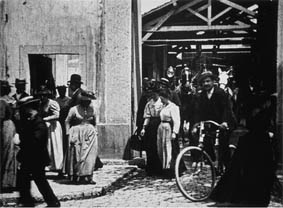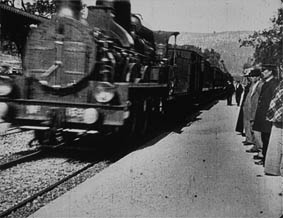1.1.4.- Las “actualidades locales” de Mitchell & Kenyon.
A comienzos del siglo XX la compañía Mitchell & Kenyon (Blackburn, 1897), fundada por los camarógrafos Sagar Mitchell y James Kenyon, realizó por encargo de distintas empresas de exhibición un conjunto de cortometrajes de actualidades publicitados como “películas locales para un público local”. Entre 1900 y 1913 recorrieron el norte de Inglaterra, Escocia, Irlanda y Gales filmando una amplia serie de cortos documentales que retrataban la vida cotidiana de personas de todas las clases sociales de la época eduardiana: sus actividades laborales, el ocio y los espectáculos deportivos, las conmemoraciones religiosas... Estas películas permanecieron olvidadas durante décadas, hasta que en 1994 fueron descubiertas en el sótano de una tienda de fotografía en Blackburn, Lancashire. Seis años más tarde, las 826 bobinas de película de nitrato fueron donadas al British Film Institute que procedió a su restauración, en colaboración con la BBC.
Con este material se realizó en primer lugar una recopilación para una serie de televisión en 3 capítulos emitida por BBC Two, The Lost World of Mitchell & Kenyon (2004), luego editada en Dvd por el BFI. Posteriormente el BFI ha editado tres nuevas compilaciones: Electric Edwardians (2005), que contiene 35 cortometrajes rodados entre 1900 y 1906 en el norte de Inglaterra; Mitchell & Kenyon in Ireland (2007), con 26 cortometrajes rodados en Irlanda entre1901 y 1902; y Edwardian Sports (2007), recopilación de cortometrajes sobre temas deportivos rodados entre 1901 y 1907.

-
The Lost World of Mitchell & Kenyon (
El mundo perdido de Mitchell & Kenyon). (Gran Bretaña, 2004) [B/N, 176 m.].
Ficha técnica. Dirección: Sagar Mitchell, James Kenyon. Restauración y edición: British Film Institute.
Contenidos.
Primera parte.
Life & Times (60 m.).
Segunda parte.
Sport & Pleasure(60 m.) .
Tercera parte.
Saints & Sinners (60 m.).
Información:
BFI.
Hilo DXC:
The Lost World of Mitchell & Kenyon (BFI, 2004). DVDrip VO.
New Yorker Video editó una versión reducida de la serie de la BBC.
-
Electric Edwardians: The Lost Films of Mitchell & Kenyon. (GB, 2005) [B/N-Color, 85 m.].
Ficha técnica. Dirección: Emma Hindley. Fotografía: Johann Perry. Música: Andrew Blaney. Productora: BBC / British Film Institute (BFI).
Intervienen: Dan Cruickshank.(presentador), Ben Bishop (Clown), Bertie Carvel (Mitchell).
Información:
Amazon.
Hilo DXC:
The Lost World of Mitchell & Kenyon (BFI, 2004). DVDrip VO.
-
Electric Edwardians: The Films of Mitchell & Kenyon (Gran Bretaña, 2005) [B/N, 85+43 m.].
Ficha técnica. Dirección: Sagar Mitchell, James Kenyon. Productora: Mitchell & Kenyon. Restauración y edición: British Film Institute (BFI).
Contenidos: Recopilación de 35 cortos rodados entre 1900 y 1906 en el norte de Inglaterra, agrupados en 5 bloques.
1.
Youth and Education (Juventud y Educación). Audley Range School, Blackburn (c.1901), Special March Past of the St Joseph’s Scholars and Special Parade of St Matthew’s Pupils, Blackburn (1905), Morecambe Church Lads’ Brigade at Drill (1901), University Procession on Degree Day, Birmingham (1901).
2.
The Anglo-Boer War (La guerra de los Boers). Torpedo Flotilla Visit to Manchester (1901), Lord Roberts’ Visit to Manchester (1901), Lieutenant Clive Wilson and the Tranby Croft Party, Hull (1902), Opening of the Drill Hall in Accrington by General Baden-Powell (1904), A Sneaky Boer (1901).
3.
Workers (Trabajadores). Messrs Lumb and Co Leaving the Works, Huddersfield (1900), Pendlebury Colliery (1901), 20,000 Employees Entering Lord Armstrong’s Elswick Works, Newcastle-upon-Tyne (1900), Alfred Butterworth and Sons, Glebe Mills, Hollinwood (1901), Parkgate Iron and Steel Co., Rotherham (1901), North Sea Fisheries, North Shields (1901), Cunard Vessel at Liverpool (c.1901).
4.
High Days and Holidays (Días de fiesta y vacaciones). Whitsuntide Fair at Preston (1906), Manchester Band of Hope Procession (1901), Blackpool Victoria Pier (1904), Leeds Athletic and Cycling Club Carnival (1902), Dewsbury v Manningham (1902), Sedgwick’s Bioscope Show Front (1901), The Great Local Derby : Accrington v Church Cricket Match (1902), Halifax Catholic Procession (c.1905), Burnley v Manchester United (1902), Sheffield United v Bury (1902), Preston Egg Rolling (c.1901).
5.
People and Places (Gentes y lugares). Living Wigan (1902), Tram Ride into Halifax (1902), Electric Tram Rides from Forster Square, Bradford (1902), Jamaica Street, Glasgow (1901), Ride on the Tramcar Through Belfast (1901), Wexford Bull Ring (1902), Manchester Street Scene (1901), Panoramic View of the Morecambe Sea Front (1901).
6.
Easter Eggs (Huevos de Pascua, contenidos ocultos en el Dvd). Diving Lucy (1903), Race for the Muriatti Cup, Manchester (1901), Comic Pictures in High Street, West Bromich (1902), Royal Proclamation of Death of Queen Victoria, Blackburn (1901), Bradford Coronation Procession (1902).
Información:
BFI.
Hilo DXC:
Electric Edwardians: The Films of Mitchell & Kenyon. DVDrip VO + Subt eng (audiocomentarios).
-
Mitchell & Kenyon in Ireland. (Gran Bretaña, 2007) [B/N, 75 m.].
Ficha técnica. Dirección: Sagar Mitchell, James Kenyon. Productora: Mitchell & Kenyon. Restauración y edición: British Film Institute (BFI).
Contenidos. Recopilación de 26 cortometrajes rodados por Mitchell & Kenyon en Irlanda entre mayo de 1901 y diciembre de 1902, agrupados en 4 bloques:
1.
Street Scenes. Ride on a Tramcar Through Belfast (1901), Cattle Market in Derry (1902), Congregation Leaving Jesuit Church of St Francis Xavier, Dublin (1902), Panorama of College Green, Dublin (1902), Congregation Leaving St Mary’s Pro-Cathedral, Dublin (1901), Wexford Railway Station (1902), Life in Wexford (1902).
2.
Life in Cork. Ride from Blarney to Cork on Cork & Muskerry Light Railway (1902), Panorama of Queenstown Harbour (1902), Albert Quay in Cork (1902), Tram Ride from King Street to Patrick’s Bridge, Cork (1902), Views of the Grand Parade, Cork (1902), Workers Leaving Lee Boot Factory – Dwyer & Co. Ltd, Cork (1902), Cork Fire Brigade Turning Out (1902), Congregation Leaving St Patrick’s Church in Cork (1902), Congregation Leaving St Mary’s Dominican Church in Cork (1902), Regiments Returned from Boer War to Victoria Barracks, Cork (1902).
3.
Cork Exhibition. Preparation of the Cork Exhibition Grounds and Erection of Buildings (1902), Panorama of Cork Exhibition Grounds (1902), Trade Procession at Opening of Cork Exhibition (1902), Arrival of VIPs for Official Opening of Cork Exhibition (1902), Lord Mayor of Cork Arriving for Official Opening of Cork Exhibition (1902), The Visit of the Duke of Connaught C-I-C Forces in Ireland and Prince Henry of Prussia to Cork Exhibition (1902).
4.
Sport. Ambush II at Eyrefield Lodge, Curragh (1902), Sports Day at Queen’s College Ground, Cork (1902), Two-Oared Boat Race, Sundays Well, Cork (1902), Crews Practicing on River Lee at Cork Regatta (1902), Final of International Cup at Cork Regatta Between Leander and Berlin (1902), England v Ireland at Manchester (1905), Wales v Ireland at Wrexham (1906).
Información:
BFI.
-
Mitchell & Kenyon: Edwardian Sports. (Gran Bretaña, 2007) [B/N, 108 m.].
Ficha técnica. Dirección: Sagar Mitchell, James Kenyon. Productora: Mitchell & Kenyon. Restauración y edición: British Film Institute (BFI).
Contenidos. Recopilación de cortometrajes sobre temas deportivos (fútbol, cricket, rugby, atletismo y ciclismo) rodados por Mitchell & Kenyon en las islas británicas entre 1901 y 1907, agrupados en 5 bloques.
1.
Sport and Leisure. Manchester to Blackpool Road Race (1903), Day School Sports at Park Avenue, Bradford (1902), Manchester and Salford Harriers’ Cyclists’ Procession (1901), Tynemouth Swimming Gala in The Haven, North Shields (1901), Trotting Match at Springfield Park, Wigan (1904).
2.
Amateur. Kingston Rowing Club at Practice (1902), Final of International Cup at Cork Regatta Between Leander and Berlin (1902), AAA Championships at Fartown, Huddersfield (1901), Champion Athletes at Birmingham (1902), Race for the Muratti Cup at Manchester Wheelers’ Annual Race Meet (1901), Manchester Wheelers’ Annual Race Meet (1901).
3.
Cricket. Arthur Mold Bowling to A.N. Hornby (1901), The Great Local Derby, Accrington v Church Cricket Match (1902).
4.
Professional Football. Newcastle United v Liverpool (1901), Rotherham Town v Thornhill (1902), Sheffield United v Bury (1902), Everton v Liverpool (1902), Notts County v Middlesbrough (1902), Bradford City v Gainsborough Trinity (1903), Blackburn Rovers v Aston Villa (1904), reston North End v Wolverhampton Wanderers (1904), Bolton v Burton United (1904-5), Preston North End v Aston Villa (1905), Sunderland v Leicester Fosse (1907).
5.
Rugby Football (Northern Union). Salford v Batley (1901), Oldham v Swinton (1901), Hunslet v Leeds (1901), Halifax v Salford (1901), Dewsbury v Manningham (1901), Warrington v St Helens (1901), Hull FC v Hull Kingston Rovers (1902), Hull Kingston Rovers v Wigan (1902), Northern Union Challenge Cup Final – Halifax v Salford (1903).
Información:
BFI.
---------------------------------------------------------------



















